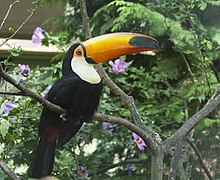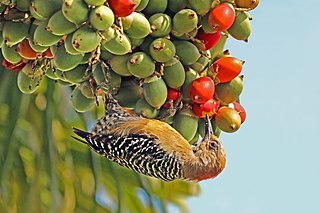
Nine families of largely arboreal birds make up the order Piciformes, the best-known of them being the Picidae, which includes the woodpeckers and close relatives. The Piciformes contain about 71 living genera with a little over 450 species, of which the Picidae make up about half.

New World barbets are near passerine birds from the family Capitonidae of the order Piciformes, which inhabit humid forests in Central and South America. They are closely related to the toucans.

The coppersmith barbet, also called crimson-breasted barbet and coppersmith, is an Asian barbet with crimson forehead and throat, known for its metronomic call that sounds similar to a coppersmith striking metal with a hammer. It is a resident bird in the Indian subcontinent and parts of Southeast Asia. It carves out holes inside a tree to build its nest. It is predominantly frugivorous, but has been observed eating insects, especially winged termites.

An aracari or araçari is any of the medium-sized toucans that, together with the saffron toucanet, make up the genus Pteroglossus.

The white-cheeked barbet or small green barbet is a species of Asian barbet found in southern India. It is very similar to the more widespread brown-headed barbet, but this species has a distinctive supercilium and a broad white cheek stripe below the eye and is found in the forest areas of the Western Ghats, parts of the Eastern Ghats and adjoining hills. The brown-headed barbet has an orange eye-ring but the calls are very similar and the two species occur together in some of the drier forests to the east of the Western Ghats. Like all other Asian barbets, they are mainly frugivorous, and use their bills to excavate nest cavities in trees.
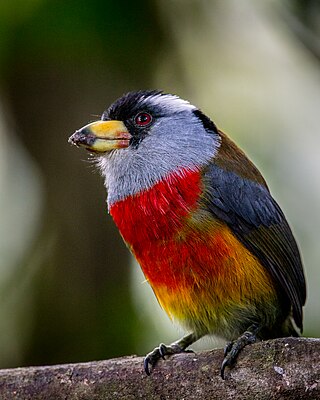
The toucan barbet is a barbet native to western Ecuador and Colombia. Along with the prong-billed barbet, it forms the family Semnornithidae, and is closely related to the toucans. It is a medium-sized barbet with a robust yellow bill. It has striking plumage, having a black head with grey throat and nape, red breast and upper belly, yellow lower belly and grey wings and tail.
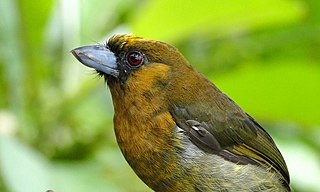
The prong-billed barbet is a distinctive, relatively large-billed bird native to humid highland forest of Costa Rica and western Panama.
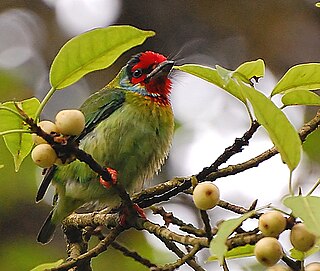
The Malabar barbet is an Asian barbet native to the Western Ghats in India. It was formerly treated as a race of the crimson-fronted barbet. It overlaps in some places with the range of the coppersmith barbet and has a similar but more rapid call.
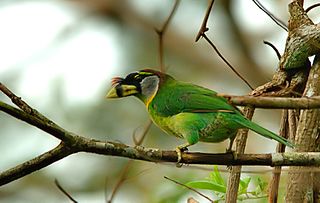
The Asian barbets are a family of bird species, the Megalaimidae, comprising two genera with 35 species native to the forests of the Indomalayan realm from Tibet to Indonesia. They were once clubbed with all barbets in the family Capitonidae but the Old World species have been found to be distinctive and are considered, along with the Lybiidae and Ramphastidae, as sister groups. In the past the species were placed in three genera, Caloramphus, Megalaima and Psilopogon, but studies show that Psilopogon to be nested within the clade of Megalaima. Since members of this clade are better treated under a single genus, they have been moved to the genus Psilopogon which was described and erected earlier than Megalaima and is therefore chosen on the basis of taxonomic priority principles. Nearly all members of the family are now in the genus Psilopogon, with the exception of those in Caloramphus, which are thought to have genetically diverged from the common ancestor around 21.32 million years ago. The latter species are distinct enough to warrant placement in a subfamily Caloramphinae. The family name is derived from that of the genus Megalaima which means ‘large throat’, from the Greek mega and laimos.

The African barbets are birds in the family Lybiidae. There are 43 species ranging from the type genus Lybius of forest interior to the tinkerbirds (Pogoniulus) of forest and scrubland. They are found throughout sub-Saharan Africa, with the exception of the far south-west of South Africa.

Lybius is a genus of African barbets from the family Lybiidae. This genus ranges across sub-Saharan Africa.

The black-browed barbet is an Asian barbet native to Peninsular Malaysia and Sumatra, where it inhabits foremost forests between 600 and 2,000 m altitude. It is listed as Least Concern on the IUCN Red List because of its wide distribution and stable population.

The scarlet-crowned barbet is a species of bird in the family Capitonidae, the New World barbets. It is found in Amazonian Brazil, Colombia, Ecuador, and Peru.
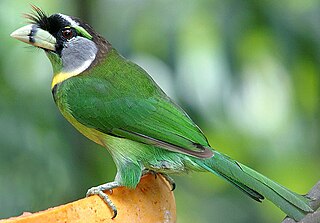
Psilopogon is a genus of Old World barbets that used to include only a single species, the fire-tufted barbet. Results of molecular phylogenetic analyses indicate that the genus is nested within an evolutionary branch consisting of Asian barbets that were formerly placed in the genus Megalaima proposed by George Robert Gray in 1841. Since Psilopogon was proposed by Salomon Müller already in 1835, this name takes priority.
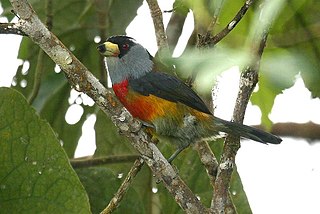
The toucan-barbets are the small bird genus Semnornis. This was often included in the paraphyletic barbets but recently usually considered a distinct family Semnornithidae; alternatively, all barbets might be moved to the toucan family Ramphastidae as a subfamily, Semnornithinae. It contains only two species, the toucan barbet and the prong-billed barbet.
Lester Leroy Short is an American ornithologist. His main research field is the order Piciformes.
Jennifer Felicity Mary Horne also known as Jenny Horne or after her marriage as Jennifer Horne-Short was a Kenyan ornithologist and bioacoustician.
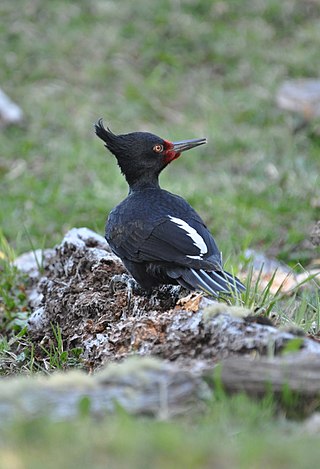
Pici is one of the two suborders of the order Piciformes and includes two infraorders Ramphastides and Picides. Members of this suborder are often called "true piciforms", as the jacamars of Galbulidae and puffbirds of Bucconidae were thought to be not closely related to toucans and woodpeckers, but instead to the order Coraciiformes. However, analysis of nuclear DNA in a 2003 study placed them as a sister group to the rest of the Piciformes, also showing that the groups had developed zygodactyl feet before separating. Per Ericson and colleagues, in analysing genomic DNA, confirmed that puffbirds and jacamars were sister groups and their place in Piciformes.

Picides is an infraorder of the order Piciformes that includes woodpeckers and honeyguides. The honeyguides were thought to be closely related to the barbets, as their aerial displays and vocalizations are more similar to each other than either are to woodpeckers. However, phylogenetic analysis has shown that honeyguides and woodpeckers are indeed sister taxa.
